What did this landscape look like before it became home to the University of Washington? What structures, movements, and individuals have come and gone since the first building was built here 125 years ago? Which histories have been popularized by those in power, and which have quietly been forgotten?
The Husky History Exploration features ten campus landmarks that help to illustrate how the University of Washington has changed and evolved throughout the past 160 years.

Commissioned in 2020 by the Burke Museum of Natural History and Culture, Guests from the Great River is a piece that describes the intricacies of the land that the University of Washington was built upon. This land wasn’t uniquely one peoples’: it’s an active eco-region filled with relationships of peoples building on the foundation of landscape learned knowledge. Learn More
Text Adapted from Owen Oliver’s Indigenous Walking Tour 2021.
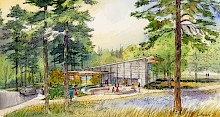
One of the largest longhouses in Coast Salish lands was in Suquamish territory, across the water from where the present-day University of Washington stands. Called ulman, or Old Man House, the longhouse was burned down to the ground in 1870 due to assimilation practices. Learn More
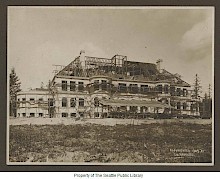
Since time immemorial, the land we now consider to be Seattle has been inhabited by the Duwamish people. White settlers first arrived in the Puget Sound in November of 1851, when a group of two dozen men, women, and children headed by Arthur Denny landed at Alki Point. Four years after the Denny Party’s arrival, the Duwamish and several other tribes and bands signed the Point Elliott Treaty of 1855, under which they agreed to exchange 54,000 acres of their homeland for the guarantees of a reservation and several other benefits. Learn More
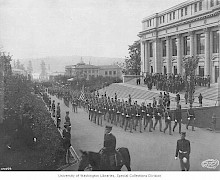
Since the University of Washington first opened its doors in 1861, thousands of students and alumni have served in the United States Armed Forces. The Interrupted Journey WWII Memorial Plaza was designed as a lasting memorial to WWII soldiers who were killed in action. Learn More
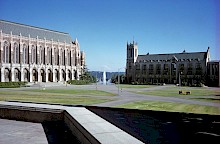
Surrounded by two libraries, a performing arts theater, a lecture hall, and the administration building, Red Square is the heart of the University of Washington’s scenic campus. Learn More

In the fall of 2003, two undergraduate students embarked upon an ambitious project: on a campus dominated by art and sculpture that glorifies primarily white, male figures, Sumona Das Gupta and Jaebadiah Gardner sought to create a lasting monument to diversity. Learn More

Between June and October of 1909, the University of Washington campus hosted the Alaska-Yukon-Pacific Exposition, a World’s Fair that attracted more than 3.5 million visitors. Fredrick Law and John C. Olmsted, who had previously been contracted to design Seattle’s park system, were hired by A-Y-P officials to design the exposition grounds. Learn More
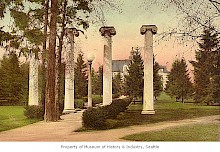
No artifacts or monuments are as symbolic of the University of Washington's history as the four columns standing before you.
Crafted from cedar, the columns were originally erected in 1861 to support the portico of the Territorial University of Washington's first building at 4th and University Street in what is now downtown Seattle. After the University's relocation to its present-day site at the end of the 19th century, the original building was demolished in 1908; however, thanks to the efforts of distinguished UW alumnus and professor Edmond Meany, the columns were preserved. Learn More
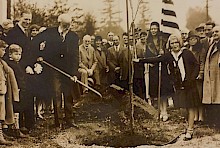
Before the University arrived at its current site on the shores of Union Bay, the 600+ acres comprising the Seattle campus were blanketed by a virgin coniferous forest. Lake Washington’s waters sat nine feet higher than their current level, and the wetlands now known as the Union Bay Natural Area were underwater. Learn More
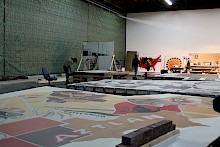
The Samuel E. Kelly Ethnic Cultural Center (ECC) is designed to empower and support historically marginalized students on the University of Washington’s campus. The ECC’s roots can be traced to the Black Student Union’s historic 1968 sit-in in University President Charles’ Odegaard’s office. Learn More

120 Mary Gates Hall Box 352825
Seattle, WA 98195-2825
206-543-4905 (Voice)
206-207-5564 (Text)